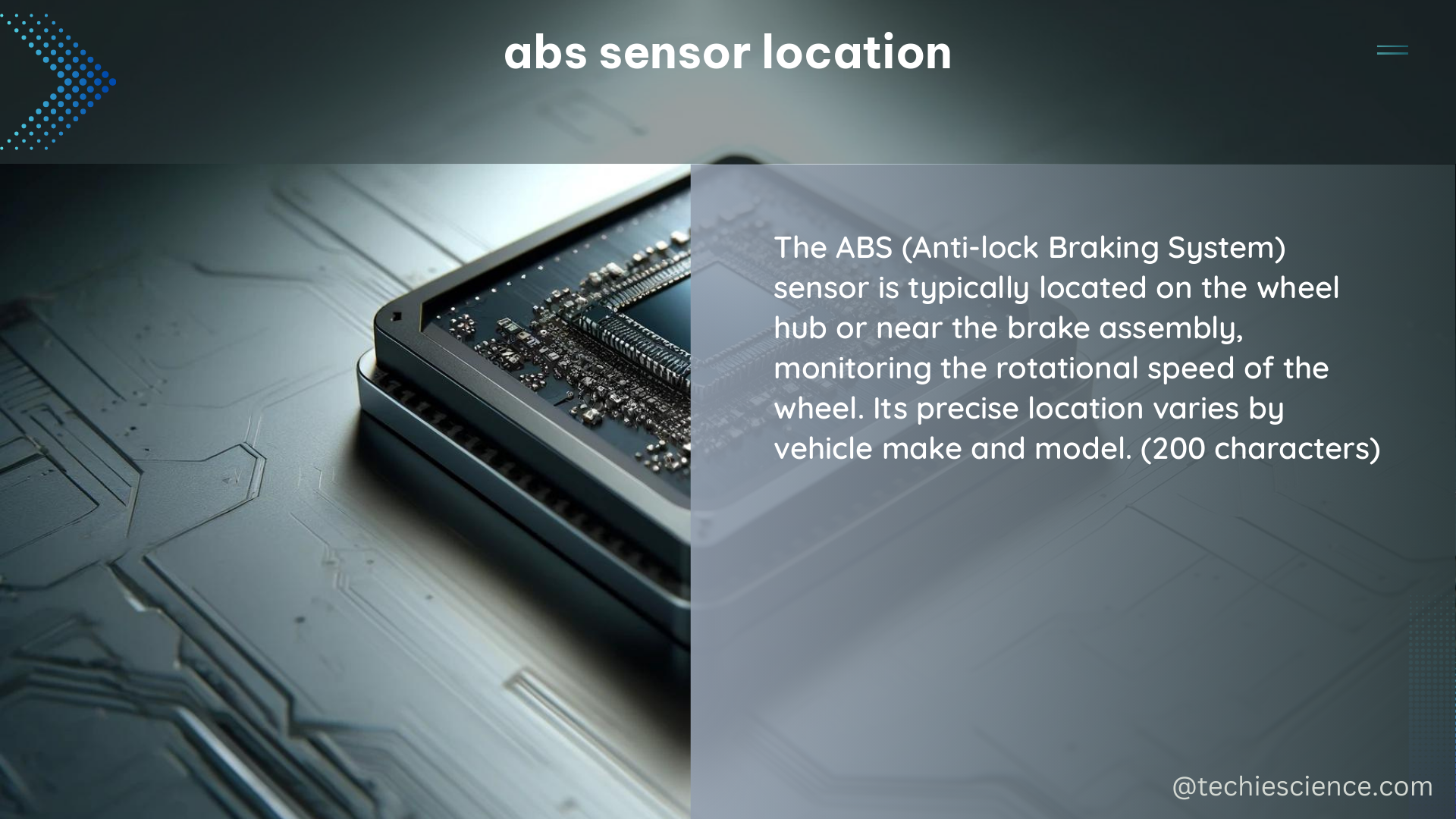The Anti-lock Braking System (ABS) sensor, also known as the wheel speed sensor, is a critical component in a vehicle’s braking and stability control systems. This sensor plays a vital role in driving dynamics, safety, comfort, fuel efficiency, and emissions. Understanding the precise location of the ABS sensor is essential for proper diagnosis, maintenance, and troubleshooting.
Technical Specifications of ABS Sensor Location
- Positioning: The ABS sensor is typically positioned directly above the impulse wheel, which is connected to the wheel hub or drive shaft.
- Sensor Design: The sensor consists of a pole pin surrounded by a winding, connected to a permanent magnet. The magnetic effect of the permanent magnet extends to the pole wheel.
- Principle of Operation: As the impulse wheel rotates, the switching from tooth to tooth space brings about a change in the magnetic field. This change in the magnetic field induces a quantifiable, or measurable, alternating voltage in the winding.
- Voltage Characteristics: The frequency and amplitudes of the induced alternating voltage are directly related to the wheel speed.
- Sensor Types: ABS sensors can be designed as either active or passive sensors, depending on their mode of operation. Active sensors require a supply voltage to operate and generate an output signal, while passive sensors operate without additional supply voltage. Both passive (2-wire) and active (2 or 3-wire) sensors are used in vehicles.
Locating the ABS Sensor: A Step-by-Step Guide

- Identify the Wheel Speed Sensor Wire: Start by locating the wheel speed sensor wire, which is typically connected to the ABS control unit.
- Follow the Wire to the Sensor: Follow the wheel speed sensor wire to the actual sensor, which is usually located near the wheel hub or drive shaft.
- Inspect the ABS Sensor: Once you have identified the ABS sensor, you can use a multimeter to test the sensor for resistance and AC voltage.
- Diagnose and Replace: If the ABS sensor is found to be faulty, it will need to be replaced with a new one.
Technical Data and Measurements
- Sensor Resistance: The resistance of a typical ABS sensor can range from 800 to 2,000 ohms, depending on the sensor type and manufacturer.
- Sensor Voltage Output: The AC voltage output of a functioning ABS sensor can range from 0.2 to 12 volts, with the voltage increasing as the wheel speed increases.
- Sensor Frequency: The frequency of the AC voltage output can range from 0.5 to 400 Hz, again depending on the wheel speed.
- Sensor Mounting Torque: The recommended mounting torque for ABS sensors can vary, but is typically between 8 to 12 Nm (5.9 to 8.9 lb-ft).
- Sensor Clearance: The recommended clearance between the ABS sensor and the impulse wheel can range from 0.2 to 1.5 mm (0.008 to 0.059 inches), depending on the specific vehicle and sensor design.
Troubleshooting and Diagnostics
- Diagnostic Tools: To diagnose a faulty ABS sensor, a code reader or scan tool can be used to retrieve live data and identify the specific sensor that is malfunctioning.
- Live Data Comparison: For example, in a Porsche with a faulty ABS sensor, the live data can be compared across all four sensors. If one sensor shows a constant zero reading while the others show normal readings, it indicates a problem with that specific sensor.
- Sensor Replacement: Once the faulty ABS sensor has been identified, it can be replaced with a new one, ensuring proper operation of the vehicle’s braking and stability control systems.
Conclusion
The ABS sensor is a critical component in modern vehicles, playing a vital role in driving dynamics, safety, and efficiency. Understanding the precise location and technical specifications of the ABS sensor is essential for proper diagnosis, maintenance, and troubleshooting. By following the step-by-step guide provided in this comprehensive manual, you can confidently locate and inspect the ABS sensor in your vehicle, ensuring optimal performance and safety.
References:
- HELLA: Check and change ABS sensor – Technical information and practical tips
- How to get ABS LIVE DATA from your car in 2 minutes – YouTube
- How to Test ABS Wheel Speed Sensors for Resistance and AC Voltage – YouTube
- How To Get ABS Wheel Speed Sensor Live Data For VW Audi Seat Skoda – YouTube
- Fundamentals of Instrumentation and Measurement – Dominique Placko

The lambdageeks.com Core SME Team is a group of experienced subject matter experts from diverse scientific and technical fields including Physics, Chemistry, Technology,Electronics & Electrical Engineering, Automotive, Mechanical Engineering. Our team collaborates to create high-quality, well-researched articles on a wide range of science and technology topics for the lambdageeks.com website.
All Our Senior SME are having more than 7 Years of experience in the respective fields . They are either Working Industry Professionals or assocaited With different Universities. Refer Our Authors Page to get to know About our Core SMEs.